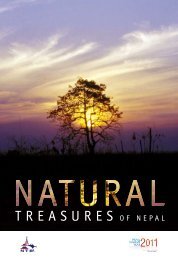treasures of nepal
treasures of nepal
treasures of nepal
- No tags were found...
Create successful ePaper yourself
Turn your PDF publications into a flip-book with our unique Google optimized e-Paper software.
Religions, Customsand Religious SymbolsHinduism is the main religion <strong>of</strong>the Nepalese people. The trinity<strong>of</strong> Hinduism - Brahma, Vishnuand Shiva - and the pantheon<strong>of</strong> numerous other Hindu godsand goddesses are devotedlyworshipped in Nepal.Nepal is a secular country. However, Hinduism is the mainreligion <strong>of</strong> the Nepalese people. The trinity <strong>of</strong> Hinduism -Brahma, Vishnu and Shiva - and the pantheon <strong>of</strong> numerous otherHindu gods and goddesses are devotedly worshipped in Nepal.The female consorts <strong>of</strong> these gods are equally venerated hereas the manifestation <strong>of</strong> ‘Shakti’ (power or cosmic energy). Thegoddesses are worshipped in different forms, such as Nav Durgas(nine Durgas), Asta Matrikas (eight mother goddesses) and SaptaMatrikas (seven mother goddesses).Buddhism is an equally important religion in Nepal.Mahayana Buddhism and Vajrayana Buddhism - acombination <strong>of</strong> Hindu and Buddhist religious faithsinfluenced by Tantric cult - have been followed particularlyin the Kathmandu Valley since medieval times. In the highHimalayan region, Tibetan Buddhism, or Lamaism, and otherforms <strong>of</strong> Nature worship are also practised by the people.Buddha Purnima, Boudha NathSiddhartha Gautama, later known to the world as Lord Buddha,was born in Lumbini in mid-southwestern Nepal in 6th centuryB.C. There are more than two dozen sites around this area whichare closely related to the life <strong>of</strong> the Buddha and Buddhism.In the course <strong>of</strong> history, Buddhism as a religion spread andbecame popular in the high mountain regions, mid-hills and inthe Kathmandu Valley. Buddhism has pr<strong>of</strong>oundly influenced theNepalese way <strong>of</strong> life, culture, arts and architecture.CustomsThe Nepalese way <strong>of</strong> life is regulated by religion through theperformance <strong>of</strong> various rites and rituals, seeking God’s grace forthe well-being <strong>of</strong> the family, prosperity and mokshya (salvation)for the self. Religious custom guides every step <strong>of</strong> a Nepalesefrom birth to death and beyond. Every important event in the life<strong>of</strong> a person from cradle to pyre is marked by performing certainreligious rites and functions. These rituals may generally differfrom community to community. A new-born child undergoesChhaithi Nwaran, the naming ceremony (6th day <strong>of</strong> birth), andAnnaprasan, the rice-feeding ceremony (5th or 6th month <strong>of</strong>13




